#Bust of Nefertiti
Explore tagged Tumblr posts
Text

#stippling#pre 2020#nefertiti#bust of nefertiti#black and white#black and white art#pen and ink#pen and ink drawing#ink drawing#pointillism#dotwork#linework#blackwork
3 notes
·
View notes
Text
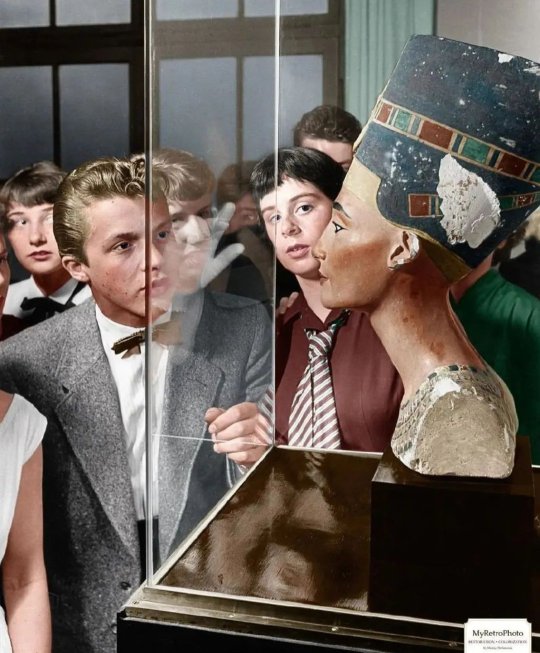
Students exploring the Bust of Nefertiti (1345 BC), exhibited in Neues Museum, Berlin, Germany (via Archaeo - Histories).
5 notes
·
View notes
Text
Berlin: Neues Museum
The Neues or New Museum is four stories and contains Egyptian artifacts on the first couple of floors. The 3rd and 4th floors are dedicated to Germanic history. From pre-history to a bit more modern. The gem of this museum is the bust of Nefertiti. The bust may be down an eye but it feels as if she is watching. There is clear quartz over the remaining eye, the light glinting off it gives a…

View On WordPress
#Berlin#Bust of Nefertiti#Europe#Germany#Museum of Prehistory#Neues Museum#Pergamonmuseum#Travel Blogger#Travel Writing
0 notes
Text
I managed to point out to my dad that the facebook post he was showing me was clearly nonsense and he ended up fact checking it. So. Progress hopefully
#fully enough my dad is actually way more reasonable than my mom#my mom the phd college professor who will randomly come out with statements like 'there are more eyewitness accounts to#jesus christs resurrection than any other event in history'#like. mom im p sure more people accounted their viewing of the moon landing. or the fucking superbowl. lol#she Refused to acknowledge ANY skepticism and was just like 'ok be athiests then!' lol i hate her#anyway#my dad showed me a picture claiming to compare nefertitis bust to king ramses tomb and how they look the same or whatever#and i was like. 'yea because that photo of ramses tomb had that photo of the bust overlayed on top of it. it doesnt actually look like that'#and he argued for a bit like 'no but thats the tomb'#until he googled it and was like oh wait yea. the post is just tricking people#like..... yup lol
6 notes
·
View notes
Text
johnny cage in mk1 when he's attacked by scorpion subzero and kenshi

johnny cage when his house in la and all his expensive stuff is completely destroyed by scorpion subzero liu kang and kenshi and it was on a loan because he's broke and he is trying to explain to home insurance why they should cover it

#bruh i was watching some fighting gameplay and his house is so nice... so many artstuff there.... his poor house....#was smoke there i don't remember#mk1#mortala kombat#johnny cage#bruh his nefertiti bust
18 notes
·
View notes
Text



The true face of Nefertiti a reconstruction based on her AUTHENTIC busts that all have consistency in their features unlike the strange famous bust which is believed to be a 20th century fraud.
This bust can be found in the Nuese museum.
The reconstruction is don't by the talented Bas uterjwick, and edited by yours truly.
The features are consistent with the artworks. However, the complexion of a person depicted will always be to the discretion of the artist. I have provided a few options. Personally, I already see the color used on the bust. I trust the ancient artist.
#nefertiti bust at nuese#nefertiti#egyptian#egypt#egyptphotography#african history#africa#kemet#egyptology#egyptian queen#bust#love egypt#egyptshots#ancient egypt#egypt tours#prince of egypt
4 notes
·
View notes
Text
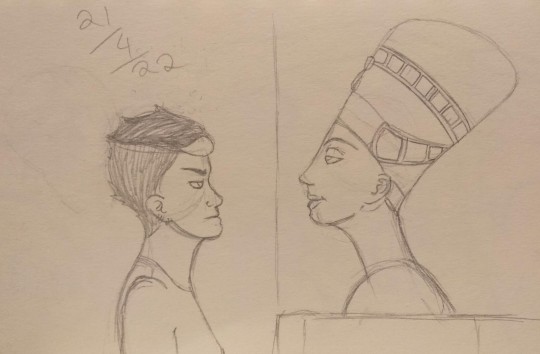
An old nemesis.
Drawn 21/04/22
#nefertiti#nefertiti bust#grudge#original character#sketch#pencil sketch#pencil drawing#sketchbook#artist on Tumblr
2 notes
·
View notes
Text
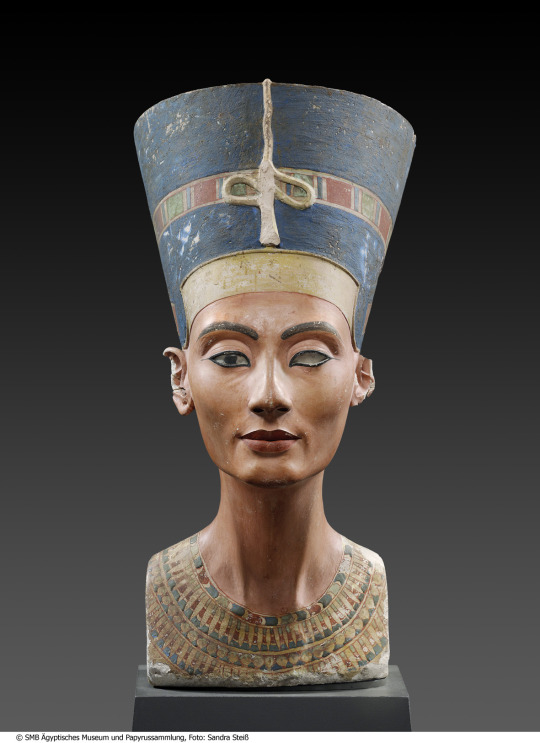
~ Bust of Queen Nefertiti.
Period: 18th Dynasty, New Kingdom; reign of Amenhotep IV/Akhenaten
Medium: Limestone, painted; stucco; beeswax, black; rock crystal.
#ancient#ancient art#history#museum#archeology#ancient egypt#ancient sculpture#ancient history#archaeology#egypt#egyptian#egyptology#Nefertiti#new kingdom#18th Dynasty#Amenhotep IV#Akhenaten
1K notes
·
View notes
Text

Torso of Queen Nefertiti
The torso is notable for its artistry and historical significance, showcasing the skilled craftsmanship of the Amarna period. Nefertiti, the wife of Pharaoh Akhenaten, is a significant figure in ancient Egyptian history, known for her beauty and for her role during a transformative period in Egyptian religion and art.
Nefertiti is often celebrated for her iconic bust, but this torso adds to our understanding of her representation in ancient art.
From Tell el-Amarna. Now in the Louvre. E 25409
Read more
644 notes
·
View notes
Text
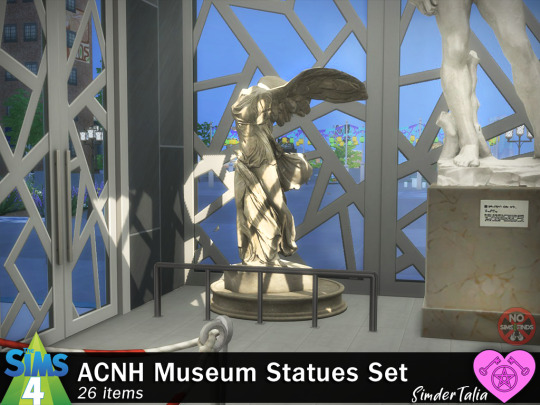
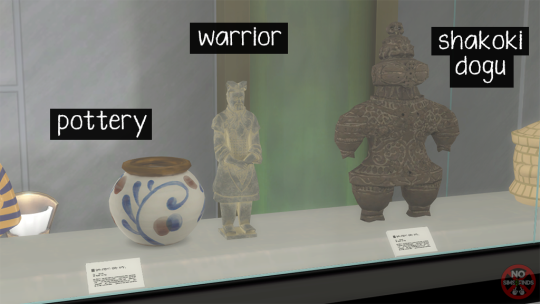
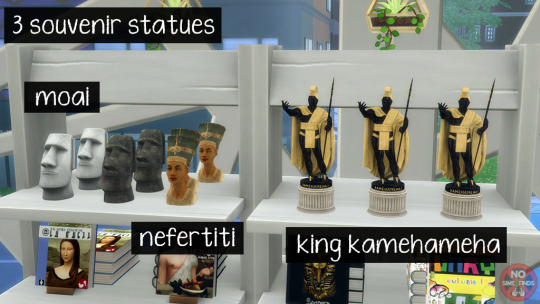
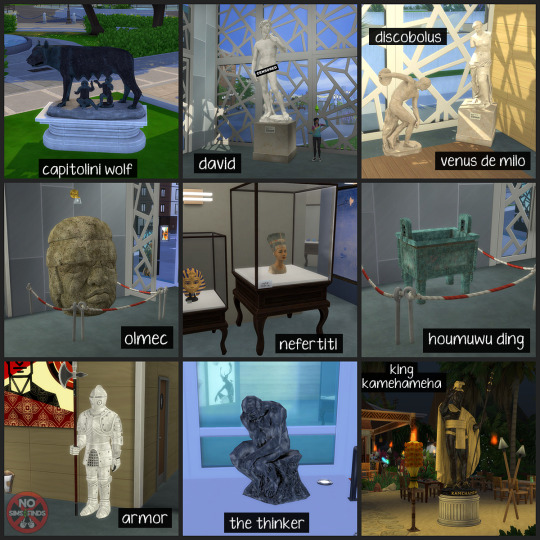

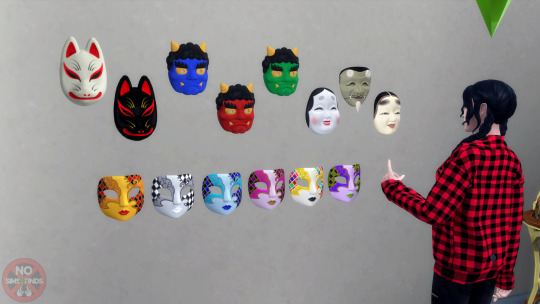

🏛️🏺 ACNH Museum Statues Set 🏺🏛️
Sims 4, base game compatible. 26 items. I hope you enjoy! This set is brought to you by the lovely patrons who voted 💗
Always suggested: bb.objects ON, it makes placing items much easier. For further placement tweaking, check out the TOOL mod.
Set Contains: -Armor | 4 swatches | 1202 poly -Capitolini Wolf | 1 swatch | 2259 poly -David | 1 swatch | 4704 poly -David Pedestal | 5 swatches | 104 poly -Discobolus | 2 swatches | 1238 poly -Houmuwu Ding | 1 swatch | 2226 poly -King Kamehameha | 1 swatch | 2410 poly -King Kamehameha Souvenir | 1 swatch | 2410 poly -Moai | 2 swatches | 3064 poly -Moai Souvenir | 4 swatches | 3064 poly -Mossy Guy | 6 swatches | 1200 poly -Nefertiti | 2 swatches | 972 poly -Nefertiti Souvenir | 2 swatches | 972 poly -Nike | 1 swatch | 3019 poly -Olmec | 2 swatches | 3498 poly -Pottery | 5 swatches | 802 poly -Shakoki Dogu | 1 swatch | 1076 poly -The Thinker | 2 swatches | 1144 poly -Venus de Milo | 3 swatches | 1138 poly -Wall Mask: Elder | 1 swatch | 1206 poly -Wall Mask: Fox | 2 swatches | 1216 poly -Wall Mask: Noh (woman's face) | 1 swatch | 1212 poly -Wall Mask: Ogre | 3 swatches | 1208 poly -Wall mask: Kokame (woman's face) | 1 swatch | 1212 poly -Wall Mask: Venetian | 6 swatches | 1602 poly -Warrior | 1 swatch | 1004 poly
Type “acnh museum statues" into the search query in build mode to find quickly. You can always find items like this, just begin typing the title and it will appear.
As always, please let me know if you have any issues!
📁 Download all or pick & choose (SFS, No Ads): HERE
📁 Alt Mega Download (still no ads): HERE
📁 Download on Patreon
Will be public on May 9th, 2024 💗
Happy Simming! ✨ Some of my sets are early access. If you like my work, please consider supporting me:
★ Patreon 🎉 ❤️ |★ Ko-Fi ☕️ ❤️ ★ Instagram📷
Thank you for reblogging ❤️ ❤️ ❤️
@sssvitlanz @maxismatchccworld @mmoutfitters @coffee-cc-finds @itsjessicaccfinds @gamommypeach @stargazer-sims-finds @khelga68 @suricringe @vaporwavesims @mystictrance15 @moonglitchccfinds @xlost-in-wonderlandx @jbthedisabledvet
-King Tut Bust-Bastet Statue -Museum Displays -More Museum Displays & Partitions -Rope Partition -Fossil Museum Sets (scroll page, sets contain other museum items) -Mini Statues Set
The rest of my CC
Please do also check out the 2 sets/collab from @aroundthesims & @mlyssimblr for the museum exhibit (lots of gift shop items):
⭐️https://sims4.aroundthesims3.com/objects/room_community_21.shtml
⭐️https://mlyssimblr.tumblr.com/post/153354021958/ats4-mlys-exhibition-set
287 notes
·
View notes
Text
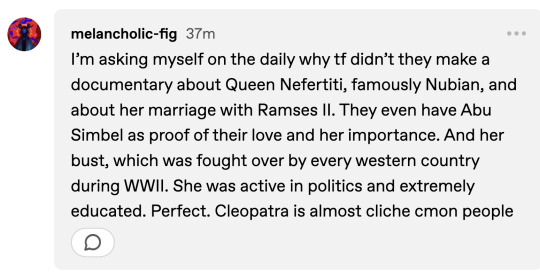
@melancholic-fig
Hi! Small correction (and using your comment to talk a little bit more about both women because I genuinely like them both very much!)
Queen Nefertiti (of the bust you're mentioning, currently in Berlin very controversially) was not the Queen married to Ramses II and depicted in the temples at Abu Simbel. Queen Nefertari is the queen that is represented in those temples. Their names are very similar and they are often confused. Unfortunately, neither Queen is thought to be of Nubian descent, but we don't often know much about Egyptian Queen's biological families, so it's entirely possible that one or both queens were ethnically Nubian, but culturally Egyptian.
Queen Nefertiti was married to Egyptian King Akhenaton, who is mostly known for turning Egyptian Religion "monotheistic" during his reign. However, it is heavily debated if Akhenaten's mother Queen Tiye was Nubian. This is mostly due to how she is represented, specially in one specific bust, during her son's reign.

(her bust is also in Berlin)
Some scholars believe that because of her features and the choice of dark wood for the bust, specially given that Akhenaten was seemingly so involved in the artistic production of his own time, prove that Queen Tiye was black and had Nubian ancestry. The opposing argument is that given that Akhenaten's chosen religion was so focused on the sun (and spending time in it) that the choice of showing her with a darker skin tone is just an emphasis of spending time in the sun. I personally fall more on the Nubian theory, but both have equally valid arguments.
One of Pharaonic Egypt's dynasty is 100% provable Nubian however and that is the 25th dynasty! All the King's and Queen's from the 25th dynasty were Nubian and they ruled Egypt around 750-650BC. Even more interesting than that is the fact that 2 princesses from the Nubian dynasty served as God's Wife of Amun. This is not only the highest religious title in Egypt during this period, but meant they effectively ruled Thebes during this period. Iconographically they are given the same treatment as the King and are the first people not calling themselves King of Egypt to do so.
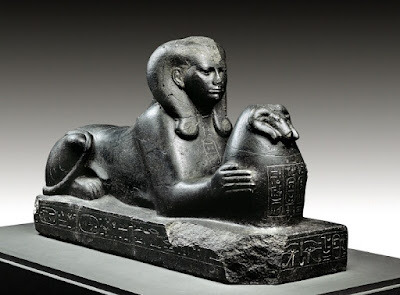
(spinx of Shepenupet II one of the Nubian God's Wives of Amun, also in Berlin)
(Also Cleo is not even ethnically Egyptian, much less black and I'm still mad about that doc being made <3 <3)
I literally just have one thing to say as an Egyptology student about the Jada Picket Smith Cleopatra “documentary”
This is a statue of a fully ethnically Egyptian priest, named Ka-aper, from around 2400BCE (aka over 2300 years before Cleopatra was even born)
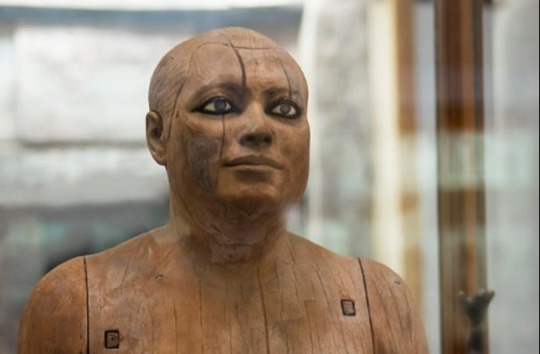
When he was found the people in the town named him Sheik Balal. Because he looked so much like their local governor.
Modern Egyptians and Ancient Egyptians are the same people - you’re just Islamophobic.
Egyptian People are not “invaders” of their own country. Saying that Cleopatra was “before the arab invasion” is Islamophobic. Perpetuating the idea that modern Egyptians “took over” their own country and it’s history is ISLAMOPHOBIC
#jo does egyptology#anyways the reason the nefertiti bust shouldn't be in berlin is because they fully lied to egyptian authorities in order#to get it out of the country
41 notes
·
View notes
Text

Nefertiti Bust (1345 BC)
#archaeology#archaeologists#egypt#egyptology#egyptologist#anthropology#artifact#artifacts#art history#1300s BC#statue#bust
798 notes
·
View notes
Note
Nefretiti
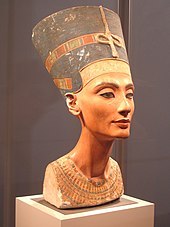
Neferneferuaten Nefertiti, or Nofretiti, (14th century BC; 18th dynasty, New Kingdom) is perhaps best well known for her bust, which has become world famous for its' uniqueness and craftsmanship. But Nefertiti played a role in one of the most controversial eras of Egyptian history. She is one of the most well-recorded Queens of ancient Egypt, but very little is known about her actual life besides conjecture.
Let's start with dissecting her name. Most people will divide her name up into the words Nefer and Titi; Nefer being a common word in ancient Egypt meaning beauty and goodness. In actuality, her name is divided up as neferet - iiti, more classically transliterated as Nfr.t-jy.tj. The t belongs to nefer as it is the denomination of a female pronoun in the ancient Egyptian language, and the jy.tj means coming or has come. All together, her name means The Beautiful One Has Come.
Nefertiti is indeed beautiful; she is, as mentioned earlier, one of the most depicted Queens of Egyptian history, with her image appearing on a great number of walls, in carvings and in paintings, and of course, statues. The reason for this is partly due to her marriage to the Heretic Pharaoh, Akhenaten. To understand this connection a little better, one must have some background about the Pharaoh Akhenaten.
Akhenaten and Nefertiti were married close to when Akhenaten was coronated, which was for him around the age of 16 or 18, and for Nefertiti was around the age of 12 to 16. Akhenaten is fairly well known Pharaoh. His controversial history has made sure of that, despite the fact that after he died, the following Pharaohs did everything in their power to rid Egypt of his memory by destroying his city and erasing all images of him. Akhenaten started off as Amenhotep IV––a name which connects him to the Egyptian God Amun, often associated with the sun, but representing hiddenness, and one of the highest and most powerful Gods of Egypt. The cult of Amun at the time of the New Kingdom was perhaps the most widespread cult of worship in Egypt, and the 18th dynasty, to which the Pharaoh Amenhotep IV belongs, is the first dynasty of the New Kingdom.
This was, apparently, unsatisfactory for the Pharaoh Amenhotep IV. Still, for the first 5 years of his reign, he followed Amun's cult, until he made a dramatic religious change to worship of the Aten; a new God that represented the sun disc. Aten was a faceless God, and the first mention of the word aten was in the Old Kingdom, and back then, it meant 'disc'. While Aten was worshipped as a mere aspect of Ra, the Sun God, in Amenhopte IV's father's (Amenhotep III) reign, Amenhotep IV decided that the Aten should be the primary deity worshipped. Amenhotep IV changed his name to Akhenaten, and worshipped the Aten above all else, as the nurturer of the world, the creator, and the giver of life. This would've likely been fine; however, Akhenaten decided that the Aten should be the only God worshipped, and banned the worship of all other Gods.
Ancient Egypt had been polytheistic since it's very earliest beginnings. Akhenaten essentially introduced monotheism out of nowhere and insisted all his subjects follow him in his new faith, outlawing all other worships, and forcing many priests to abandon the temples of other Gods. Additionally, ancient Egyptians were very accustomed to using an image to worship a God; the image usually being an animal, human, or an animal-headed human. But the Aten was a disc. Although the Aten had been worshipped in Amenhotep III's reign as a falcon-headed solar deity, Akhenaten insisted that the Aten be only shown as a disc with rays reaching out, with small hands on each ray.
Obviously, this caused a lot of dissent in Egypt and the following reigns.
Another interesting point of contention was the fashion in which the Aten interacted with the royal family. In the past, the Pharaoh was connected to the Gods more than any other human––he was the bridge between the two worlds, and the mediator between humanity and the Gods. This was, generally, not a task shared by the whole of the royal family. But in Atenism, the Aten would only shine its life-giving rays onto the Pharaoh and his royal wife; in this case, Akhenaten and Nefertiti. Thus the people, if they wanted to experience the life and love of the only, legally worshippable God, would have to go through the Pharaoh and his wife. This power would've likely, at least in part, been given to the royal family in order to cement their changes, and protect them from any backlash.
This massive change in culture and religion had great affects on ancient Egypt at the time. The style of ancient Egyptian art changed drastically, and the figures of the royal family were now represented as sinuous and gangly, often with large, sagging bellies and breasts, and curved, graceful facial features. Since Akhenaten and Nefertiti, as the royal family, were so important to this new religion of Atenism, the two of them were depicted in a number of scenes––many of them unique to the Amarna period, which is the name for the period in which Atenism was installed. These scenes were familial in nature; depicting the royal couple sitting with their children and bathing in Aten's life-light, throwing gifts down to the people, and engaging with one another. This is one of the main reasons that Nefertiti is the most widely-depicted Queen of Egypt. Not only is she depicted often as the wife of Akhenaten, but she is drawn in her own right––she makes offerings to the Aten on her own, and there are depictions of her smiting the enemies of Egypt, which is a role traditionally given solely to the Pharaoh.
Another piece of evidence for the high status of Nefertiti comes from this famous depiction of the royal Amarna family:
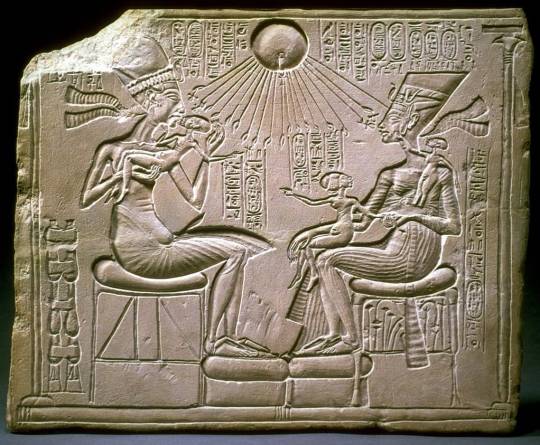
Here, Nefertiti sits on the right side, opposite her husband, Akhenaten. Akhenaten is holding up one of his children, and Nefertiti holds another two children; three of the six daughters that Nefertiti would bear for Akhenaten. The children are depicted in an almost grotesque, alien fashion, though it's not something you can really fault the artists for; it took a long time for artists across the world to realize that babies are not, in fact, just tiny humans, and that their proportions are different. Still, the style of the Amarna period is not helpful; with their large, oval heads, thin limbs, and sagging stomachs, it is difficult to imagine that anyone could be traditionally, Egyptian beautiful. Yet there is still a strange beauty to it; the sagging bellies are meant to call to mind Hapi, a God of great fertility, and the artist's ability to capture the facial features and emotions of their subject is amplified by this new and forgiving artstyle.
This image is a house altar. What that means is that people were encouraged, and evidentially did, worship the royal family in their homes, which is somewhat unprecedented. House altars were usually for Gods such as Tawaret and Bes, who were protectors of the household. But now, with traditional Egyptian religion banned, the typical house altar was now a shrine to Akhenaten and Nefertiti, and by extension, their children, which again shows the importance and power bestowed upon not just the Pharaoh, but his wife as well, as the two are represented in equal size.
Another interesting note about this particular house altar is the thrones on which Akhenaten and Nefertiti are seated. While Akhenaten's seat is mostly blank, Nefertiti is seated upon a throne reserved only for Pharaohs, the reason for this being the decorations which depict the Sema-Tawy ritual; the conjoining of the two lands.
Some time during the course of Akhenaten's reign, he decided to move the capital of Egypt to a deserted stretch of land along the Nile Valley, and called the new city Amarna, for which the period was named after. Here, the royal family took up residence, and this is where the cult center of the Aten would carry out its worship. This is also where Akhenaten royally screwed up his duties in foreign diplomacy, but that is a story for another day.
Before moving to Amarna, Nefertiti had three daughters in Thebes, the previous capital, and three more daughters in Amarna. In order, her daughter's names were Meritaten, Meketaten, and Ankhesenpaaten; then in Amarna, Neferneferuaten Tasherit, Neferneferure, and the youngest, Setepenre. It was to a lesser wife of Akhenaten's that the famous boy Pharaoh Tutankhamun was born, and originally, his name was Tutankhaten.
During his reign, when concerning Nefertiti, Akhenaten placed special attention upon her and loved her dearly, which is why she was one of the most powerful Queens of Egypt. Akhenaten described her as "possessed of charm" and "sweet of love", that "one is happy to hear her voice," and that "contents the Aten with her sweet voice". The two husband and wife were rarely depicted separately, and Akhenaten gave Nefertiti the title of 'heiress', although she was not the daughter of a King. Instead, what many scholars believe Akhenaten meant by this, was that she was to be his successor.
After Akhenaten's death, two Pharaohs ruled for a short time before Tutankhamun took over, and one of those Pharaohs is believed to have possibly been Nefertiti under the name of Neferneferuaten, which means beautiful is the beauty of the Aten. It is still debated whether this was in fact Nefertiti, but given that Nefertiti had given herself the name Neferneferuaten far before Akhenaten's death, and the elvated status gifted by her husband, it seems somewhat likely.
In essence, due to the circumstances of her life and her husband, Nefertiti was elevated to a status that never came before or after her life. Women in ancient Egypt were awarded the same rights as a man, but the wife of the Pharaoh was never depicted as equal to the Pharaoh in such a fashion, as being Pharaoh meant being the intermediary between the heavenly and the earthly, and was a special accorded honour. Nefertiti, perhaps due in part to her charisma and beauty, was given a position equal to the Pharaoh, which never happened unless it was a woman who was becoming Pharaoh. As controversial as Akhenaten's reign was, he did love his wife greatly.
I want to share my opinion on this subject a little, which is essentially to say, that I don't like Akhenaten and I don't try to hide it. His worship of the Aten is alright, but it is the banning of all other worship which rests very uneasily in me. That being said, there is a good source which goes more into detail about Nefertiti, and it is very pro-Akhenaten and anti-ancient Egyptian religion, instead glorifying the monotheism of Atenism and such. Still, it is a valuable resource; Nefertiti and Cleopatra: Queen-monarchs of Ancient Egypt, by Julia Samson, and can be found on Internet Archive here.
138 notes
·
View notes
Text
My love,take your time by bastigod is such a fic like....wow
@bastigod interpretation of the immortal who watches their lover die over and over and over again while still living on is so raw
Sakusa's writing in this fic is probably my favorite one ever.Him dealing with his own despair and problems while also trying to juggle the past and present is genuinely my favorite thing about this fic.The way the museum constantly reminds him of his past(The bust of Nefertiti,the statue of the twins etc) while also dealing with the very much present situation he is in(Atsumu's death,the breakup,the constant reminders of his love by the people he works with).CHEF KISS
The ending is genuinely so insane like.....how is this legally free for me to read.
On my first read,I was in so much shock and wonder that I couldn't even begin to comprehend it.Mind you,this is a FANFIC
#bastigod#in my mind we are friends#haikyuu#sakuatsu#miya atsumu#sakusa kiyoomi#sakuatsu fic#my love take your time
9 notes
·
View notes
Text

Recently watched: Nefertiti, Queen of the Nile (1961) (Italian title: Nefertite, regina del Nilo). Tagline: “The fascinating woman who deserted the pharaoh for the arms of the artist who made her immortal.” This one hails from the fun late fifties / early sixties “Hollywood on the Tiber era” when American movie stars - suddenly cut loose from their major studio contracts - fled to Cinecittà in Rome to extend their careers by starring in Italian-made historical epics and gladiator/ peplum movies (think: Lex Barker, Anita Ekberg, Jayne Mansfield and Mickey Hargitay). Here, the slumming American actors are Jeanne Crain and Vincent Price (and British male starlet manqué Edmund Purdom). The plot plays wildly fast-and-loose with the story of ancient Egyptian royalty Nefertiti. Here, she is originally temple handmaiden Tanet (Crain), whose true love is Tumos (Purdom), the artist who sculpted the famous bust of her. Unfortunately, scheming Great High Priest Benakon (Vincent Price) – who also happens to be her father – has promised Tanet’s hand in marriage to religious zealot pharaoh (Amedio Nazzari) – the union that will lead to her being rechristened as Nefertiti. Heaving her bosom and pining in the background is one of Tumos’ besotted models, belly dancer Merit (with her frosted pale lipstick and bouffant hairdo, Liana Forfeit looks like she should be en route to a 1961 cocktail lounge). Anyway, a visibly uncomfortable Crain makes for the most Californian of ancient European queens but rocks some great costumes (you find yourself waiting for each fresh headdress, wig and gown Crain will wear in every new scene). And the production values are lavish: there is spectacle, legions of extras, pageantry, battle scenes and banquet scenes, religious rituals, Purdom wrestles a lion – and the male actors sport ultra-short togas. (Nefertiti sometimes feels like a dry run for the more ambitious Elizabeth Taylor 1963 version of Cleopatra). Finally, all due regards to Crain, but the REAL queen here is the scene-stealing Price, camping it up outrageously with an elaborately braided wig, leopard skin cape and a kohl-rimmed smoky eye. Nefertiti is easy to find on YouTube.
#nefertiti#nefertiti queen of the nile#cinecittà#hollywood on the tiber#italian movies#peplum movies#biblical epic#historical epic#sword and sandal movie#ancient egypt#lobotomy room#kitsch#jeanne crain#vincent price#edmund purdom#camp#retro#italian cinema
12 notes
·
View notes
Text

Egyptian Gods face study
Fun fact: I base a lot of the faces of the Egyptian gods on statues of ancient Egyptian royalty. Isis is based on a bust of Nefertiti and Osiris is based on a statue of Djoser.
#art#drawing#egyptian mythology#egyptian gods#isis goddess#aset#nephthys#nebt-het#osiris#usir#set#sketchbook#face study#artists on tumblr#traditional art
12 notes
·
View notes